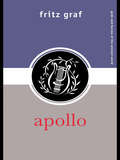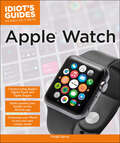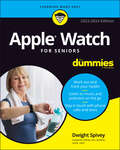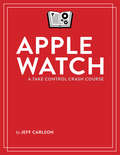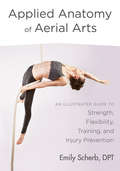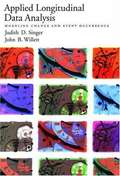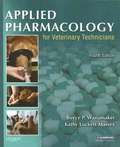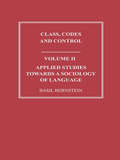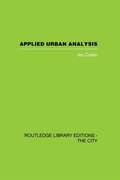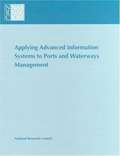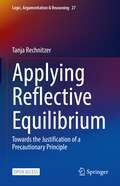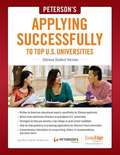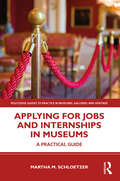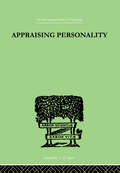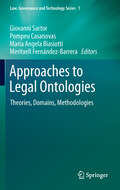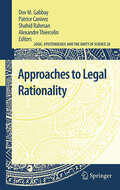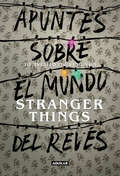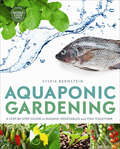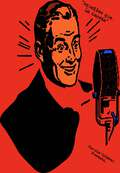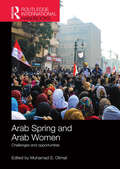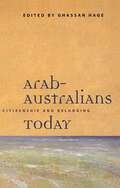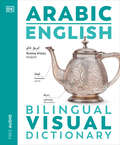- Table View
- List View
Apocalypse Now (SparkNotes Film Guide)
by SparkNotesApocalypse Now (SparkNotes Film Guide) Making the reading experience fun! SparkNotes Film Guides are one-stop guides to great works of film–masterpieces that are the foundations of filmmaking and film studies. Inside each guide you&’ll find thorough, insightful overviews of films from a variety of genres, styles, and time periods. Each film guide contains: Information about the director and the context in which the film was made Thoughtful analysis of major characters Details about themes, motifs, and symbols Explanations of the most important lines of dialogue In-depth discussions about what makes a film so remarkable SparkNotes Film Guides are an invaluable resource for students or anyone who wants to gain a deeper understanding of the great films they know and love.
Apollo (Gods and Heroes of the Ancient World)
by Fritz GrafFritz Graf here presents a survey of a god once thought of as the most powerful of gods, and capable of great wrath should he be crossed: Apollo the sun god. From his first attestations in Homer, through the complex question of pre-Homeric Apollo, to the opposition between Apollo and Dionysos in nineteenth and twentieth-century thinking, Graf examines Greek religion and myth to provide a full account of Apollo in the ancient world. For students of Greek religion and culture, of myth and legend, and in the fields of art and literature, Apollo will provide an informative and enlightening introduction to this powerful figure from the past.
Apple Watch (Idiot's Guides)
by Mr. Dwight SpiveyCombining in-depth information and easy-to-understand full-color instructions, Idiot&’s Guides®: Apple Watch will be just as integral to an Apple Watch user&’s experience as the iPhone, which must be utilized in conjunction with Apple Watch. This book features practical, expert explanations for all aspects of the Watch, directions on how to incorporate the Watch into your daily life, and other tips and information, as well as thorough explanations of the built-in apps. Idiot&’s Guides®: Apple Watch covers: - The brand-new Watch OS user interface. - How to: connect your iPhone to your Apple Watch and Apple TV. - Customize your Watch to suit your needs. - Monitor your calendar and schedule. - Access iTunes from your wrist via Bluetooth. - Incorporate your Watch into your health and fitness regimen. - Use Siri to help you with tasks, messaging, and more. - Work with third-party apps to enhance your experience and much more!
Apple Watch For Seniors For Dummies
by Dwight SpiveyAll the info you want about Apple Watch, and none of the fluff you don’t Apple Watch For Seniors For Dummies helps you get the most out of your smart device. Start with the very basics if you’re an Apple Watch newbie, or, if you’re upgrading, check out the no-nonsense coverage of the latest bells and whistles. The upgraded Sleep app, Afib monitoring that you can share with your doctor, the new Medications app for logging prescriptions, and, of course, all the texting, weather, and fitness features Apple users love. This book is packed with all the information you need to get up to speed on the latest versions of the Apple Watch and watchOS 9. For users in the 60+ crowd, this For Seniors guide uses a larger font for text and a larger size for figures to make the book as easy to read as possible. You’ll also find Tips, Warnings, and Notes to help you stay safe while you make the most out of your watch and avoid common mistakes. Yep, it’s a computer for your wrist. Let this friendly guide show you all it can do. Take a simple, step-by-step approach to getting started with Apple Watch Select the right watch model for your needs and link it to your iPhone or Mac Send text messages, receive calls, and keep track of your health—from your wrist Learn the ins and outs of the latest models for 2023-2024Interested in keeping up with the latest technology trends? Get on board the Apple Watch train, thanks to this handy resource.
Apple Watch: A Take Control Crash Course
by Jeff CarlsonExplore all the Apple Watch's capabilities and possibilities!You'll like your Apple Watch as much as author Jeff Carlson does after you've read this book and used its advice to integrate the Apple Watch into your life, taking advantage of its many features for helping you focus on what you care about the most. That could mean not missing notifications to help you keep up with co-workers, being free to stash your iPhone so you can enjoy the sunset without worrying that your sitter is trying to reach you, making sure you move enough to fill your activity rings for the day, or any other of a million things that make the watch right for you.Jeff walks you through getting to know the Apple Watch, complete with a chapter on picking one out if you haven't already, along with topics that teach you how to navigate among the watch's screens with the physical controls, taps on the screen, and the Siri voice assistant. You'll also find advice on customizing watch faces and their complications, getting the notifications you want, handling text and voice communications, and using Apple's core apps. A final chapter discusses taking care of your Apple Watch, including recharging, restarting, resetting, and restoring.Read this ebook to Take Control of:Picking out your own Apple WatchMaking watch face complications work for youKey settings that most people will want to know aboutUnderstanding how the watch interacts with your iPhonePlacing and receiving phone calls on the watchSending default (and customized) text messagesSeeing email from only certain peopleAdding events to your calendar with SiriGlancing at what's next in your daily scheduleManaging reminders on your wristLoading your watch with photosUsing the watch as a button for your iPhone cameraUsing Apple Pay from your watchPutting tickets in your watchTaking the Apple Watch out for exerciseSending sketches and heartbeats to other Apple Watch ownersGetting navigation directionsControlling an Apple TV or iTunes on the Mac with the Remote appResetting a messed-up Apple Watch and force-quitting an app
Applied Anatomy of Aerial Arts: An Illustrated Guide to Strength, Flexibility, Training, and Injury Prevention
by Emily ScherbAn illustrated guide to anatomy and biomechanics for aerialists who want to optimize their performance and train safelySpecifically designed for aerialists—including those who do trapeze, silks, and other aerial arts— Applied Anatomy of Aerial Arts is an invaluable resource for those who want to optimize their performance and train safely. Using a biomechanical and movement-based approach, Emily Scherb—a physical therapist who specializes in the care, treatment, and education of circus performers—explains the anatomical rationale for progressions of learning and demonstrates simple movements to achieve the coordination, muscular control, strength, and fitness to hang with correct form, how to progress from hanging into a pull up, an inversion, and beyond with a strong center, precise muscle sequencing, and ease of movement. Aerialists will learn how bones, joints, muscles, and soft tissues allow for specific movements and gain an appreciation for concepts of proximal stability. This full-color illustrated guide lays a solid foundation for beginners and advanced students with a wealth of insights into their own performance as well as refreshers on fundamentals in warm ups and conditioning. It explains how to structure a training session, how to care for injuries, and best practices for basic self first aid.
Applied Longitudinal Data Analysis: Modeling Change and Event Occurrence
by Judith D. Singer John B. WillettChange is constant in everyday life. Infants crawl and then walk, children learn to read and write, teenagers mature in myriad ways, the elderly become frail and forgetful. Beyond these natural processes and events, external forces and interventions instigate and disrupt change: test scores may rise after a coaching course, drug abusers may remain abstinent after residential treatment. By charting changes over time and investigating whether and when events occur, researchers reveal the temporal rhythms of our lives. Applied Longitudinal Data Analysis is a much-needed professional book for empirical researchers and graduate students in the behavioral, social, and biomedical sciences. It offers the first accessible in-depth presentation of two of today's most popular statistical methods: multilevel models for individual change and hazard/survival models for event occurrence (in both discrete- and continuous-time). Using clear, concise prose and real data sets from published studies, the authors take you step by step through complete analyses, from simple exploratory displays that reveal underlying patterns through sophisticated specifications of complex statistical models. Applied Longitudinal Data Analysis offers readers a private consultation session with internationally recognized experts and represents a unique contribution to the literature on quantitative empirical methods.
Applied Pharmacology for Veterinary Technicians (4th Edition)
by Boyce P. Wanamaker Kathy Lockett MasseyDesigned specifically for veterinary technicians, this essential resource offers detailed guidance on key topics such as managing medication inventory, dispensing veterinarian prescribed drugs, calculating drug dosages, administering medications to animals, and educating clients about drug side effects and precautions. Up-to-date drug information is presented in a consistent, easy-to-use format that includes pharmacokinetics, pharmacodynamics, clinical uses, dosage forms, and adverse side effects. Illustrated, step-by-step procedures demonstrate proper administration techniques for common drug forms. Learning Objectives at the beginning of each chapter help you focus your study efforts and check your progress as you work through the material. Chapter outlines provide at-a-glance overviews of the topics featured in each chapter, making it quick and easy to find information. Key Terms lists with definitions familiarize you with the terminology used in each chapter. Technicians Notes boxes throughout the book provide useful hints and important reminders to help you avoid common errors and increase your efficiency. Coverage of inventory control offers practical tips on performing this important task, including understanding the different vendor types, communicating with sales representatives, and using veterinary practice management computer software. Detailed summaries of important drug laws, such as the Animal Medicinal Drug Use Clarification Act and the Animal Drug Availability Act, introduce you to the legal and ethical aspects of veterinary pharmacology. The companion CD-ROM contains a handy drug dosage calculator and photographs of drug labels to familiarize you with the drug information youll encounter in practice. Proprietary drug names are listed along with generic names to help you learn to recognize drugs with generic options. Additional review questions in this edition help reinforce your understanding of key concepts. Answers are located in the back of the book so you can check the accuracy of your responses. The chapter on Drugs Used in Skin Disorders offers expanded coverage of the anatomy and physiology of the skin, as well as the latest drugs used to treat skin disorders.
Applied Studies Towards a Sociology of Language
by Basil BernsteinThe papers in this second volume show some of the results of the empirical exploration of Bernstein's hypothesis. The volume represents a significant contribution not only to the study of the sociology of language, but also to education and the social sciences. "This collection demonstrates the magnitude of Bernstein's pioneering contribution to socio-linguistic studies" - S. John Eggleston, Times Educational Supplement
Applied Urban Analysis: A critique and synthesis
by Ian CullenMuch of the theoretical literature in planning and human geography at present is materialist in perspective. This offers a powerful critique but locates the dynamics of urban systems too specifically in just one basic social relationship. It fails to provide an intellectual base broad enough for constructive, detailed urban analysis, partly because it fails to do justice to the reflective awareness of the individual. The alternative humanist position redresses the balance in favour of the individual but again cannot serve the practical requirements of urban analysis since it so often ignores social or contextual analysis. Ian Cullen synthesizes these tow apparently inconsistent theoretical positions and to render the increasingly obscure debate between them accessible. This book was first published in 1984.
Applying Advanced Information Systems To Ports And Waterways Management
by National Research CouncilThe future safety of maritime transportation in the United States-a major factor in the nation's international trade and economic well-being-will depend heavily on the quality of port and waterways information systems. <P><P>Many U.S. ports and waterways lack adequate information services, although certain elements of advanced systems are now available in some locations. Barriers to improvements in information systems include the division of responsibilities for waterways management among multiple agencies at all levels of government, a lack of coordination among the federal agencies responsible for waterways management, inadequate budgets for some critical maritime programs, the high costs of some specialized technologies, stakeholder opposition to user fees, limited access to certain key data, the incompatibility of many independently developed systems, and the absence of standards for some attractive technologies.
Applying Life Skills
by Eddye Eubanks Joan Kelly-PlateApplying Life Skills, formerly known as Today's Teen, is a major revision of this hands-on comprehensive Family & Consumer Sciences program. This new edition blends a practical, hands-on approach with a fresh new design, interesting features, and new photographs to enhance readability and promote learning. Students will learn and apply essential life skills.
Applying Life Skills: Student Edition (Todays Teen)
by Glencoe McGraw-Hill StaffPrepare your students for success and life with Glencoe's Applying Life Skills! Projects ensure that all students can learn and understand through hands-on applications. Vital Financial Literacy activities with math integration give students the practice they need, while Stay in School features help them learn and practice study skills to achieve academic success. The fully revised text has been correlated to the new FACS standards. New and revised academic integration - with relevant standards cited at point of use - includes Math, Science and English Language Arts. FCCLA activities help students connect and build relationships that can provide focus and guidance; nutrition, health, and safety basics are provided through activities that are relevant to their world. Career features encourage the development of 21st Century skills students will need, and Character Counts and Community Connections activities will help them develop lifelong values.
Applying Reflective Equilibrium: Towards the Justification of a Precautionary Principle (Logic, Argumentation & Reasoning #27)
by Tanja RechnitzerThis open access book provides the first explicit case study for an application of the method of reflective equilibrium (RE), using it to develop and defend a precautionary principle. It thereby makes an important and original contribution to questions of philosophical method and methodology. The book shows step-by-step how RE is applied, and develops a methodological framework which will be useful for everyone who wishes to use reflective equilibrium. With respect to precautionary principles, the book demonstrates how a rights-based precautionary principle can be constructed and defended. The case study succeeds in demonstrating that RE can be successfully applied and puts real constraints on the justification process. This is all the more remarkable as the case study was designed as an open-ended process, without presupposing any specific results. This book will be highly relevant both to people interested in philosophical methodology and epistemology, as well as to researchers who are interested in using philosophical methods and tools and applying them to practical problems.
Applying Successfully to Top US Universities
by Jason MorrisPeterson's Applying Successfully to Top U.S. Universities is a unique guide that assists highly ambitious Chinese students to get accepted to one of the top-ranked higher-education institutions in the United States, to both undergraduate and graduate programs of study. The book starts out with a general overview of what to expect from receiving a higher education in the United States, from earning a degree to financial aid, from campus life to the academic calendar. You will find an entire chapter dedicated to the rankings of schools and universities: who creates the rankings, how to read them, and what to do with the information provided by them. This book also offers extensive information about the language proficiency and admittance tests you may have to take and advice on how to handle the financial aspect of a U.S. education, with a list of scholarships and financial aid available. You will find valuable strategies for building a strong and successful application, with special emphasis on creating an outstanding essay or statement of purpose and securing strong letters of recommendation. The book concludes with extensive advice from admission officers and successful international students.
Applying for Jobs and Internships in Museums: A Practical Guide (Routledge Guides to Practice in Museums, Galleries and Heritage)
by Martha M. SchloetzerApplying for Jobs and Internships in Museums offers a straightforward approach to applying for positions within a museum. Martha M. Schloetzer provides practical advice about the application and interview process that will prepare emerging museum professionals as they approach the profession. From reviewing job and internship postings to developing a solid resume and writing distinctive cover letters, this guide provides practical, sound advice for museum job seekers. Schloetzer integrates the stories of successful and unsuccessful interns and job applicants throughout the book’s narrative, and recognizing the additional challenges faced by non-US nationals, the book also offers information specifically for international students seeking work experience in US museums. The insider information included in Applying for Jobs and Internships in Museums makes it a key resource for both a US and international audience interested in gaining museum experience in the US. It will be of particular interest to college-level and graduate school students, as well as recent graduates. The guide can also serve as a reference in the classroom, helping professors and instructors prepare students for the job search ahead.
Appraising Personality: THE USE OF PSYCHOLOGICAL TESTS IN THE PRACTICE OF MEDICINE
by Harrower, MollyFirst Published in 1999. Routledge is an imprint of Taylor & Francis, an informa company.
Approaches to Legal Ontologies: Theories, Domains, Methodologies (Law, Governance and Technology Series #1)
by Giovanni Sartor Mariangela Biasiotti Meritxell Fernández-Barrera Pompeu CasanovasThe book provides the reader with a unique source regarding the current theoretical landscape in legal ontology engineering as well as on foreseeable future trends for the definition of conceptual structures to enhance the automatic processing and retrieval of legal information in the Semantic Web framework. It will thus interest researchers in the domains of the SW, legal informatics, Artificial Intelligence and law, legal theory and legal philosophy, as well as developers of e-government applications based on the intelligent management of legal or public information to provide both back-office and front-office support.
Approaches to Legal Rationality (Logic, Epistemology, and the Unity of Science #20)
by Dov M. Gabbay Patrice Canivez Shahid Rahman Alexandre ThiercelinLegal theory, political sciences, sociology, philosophy, logic, artificial intelligence: there are many approaches to legal argumentation. Each of them provides specific insights into highly complex phenomena. Different disciplines, but also different traditions in disciplines (e.g. analytical and continental traditions in philosophy) find here a rare occasion to meet. The present book contains contributions, both historical and thematic, from leading researchers in several of the most important approaches to legal rationality. One of the main issues is the relation between logic and law: the way logic is actually used in law, but also the way logic can make law explicit. An outstanding group of philosophers, logicians and jurists try to meet this issue. The book is more than a collection of papers. However different their respective conceptual tools may be, the authors share a common conception: legal argumentation is a specific argumentation context.
Apuntes sobre el mundo del revés. Una guía no oficial de Stranger Things
by Adams GuyLa guía definitiva para desvelar todos los secretos de Stranger Things . Devoraste Stranger Things en menos de una semana y acabar de verla te ha dejado con un vacío del tamaño de un Demogorgon. No te preocupes, tiene solución: Apuntes sobre el mundo del revés es una guía para descubrirlo todo sobre los orígenes de la serie. Incluye una incomparable banda sonora de los 80 y un montón de hechos tenebrosos, además de test graciosos y curiosidades para que estés preparado para disfrutar al máximo de la próxima temporada. Si quieres saber cuál es la influencia que Steven Spielberg ha tenido en la serie, qué libros de Stephen King deberías leer (spoiler: casi todos) o de dónde ha salido el nombre de David O'Bannon (el policía que encuentra el cadáver de Will), este es el libro perfecto para ti. Haz acopio de Eggos y viaja a Hawkins, Indiana. ¡Y que no se te olviden las luces de Navidad!
Aquaponic Gardening: A Step-by-Step Guide to Raising Vegetables and Fish Together (Mother Earth News Books for Wiser Living)
by Sylvia Bernstein&“I have always wanted to figure out how to do sustainable aquaculture in the context of my home garden. Finally I&’ve got the book to help me do it.&” —Paul Greenberg, New York Times–bestselling author, Four Fish: The Future of the Last Wild Food Aquaponics is a revolutionary system for growing plants by fertilizing them with the waste water from fish in a sustainable closed system. A combination of the best of aquaculture and hydroponics, aquaponic gardening is an amazingly productive way to grow organic vegetables, greens, herbs and fruits, while providing the added benefits of fresh fish as a safe, healthy source of protein. On a larger scale, it is a key solution to mitigating food insecurity, climate change, groundwater pollution and the impacts of overfishing on our oceans.Aquaponic Gardening is the definitive do-it-yourself home manual, focused on giving you all the tools you need to create your own aquaponic system and enjoy healthy, safe, fresh and delicious food all year round. Starting with an overview of the theory, benefits and potential of aquaponics, the book goes on to explain: System location considerations and hardware components The living elements—fish, plants, bacteria, and worms Putting it all together—starting and maintaining a healthy system. Aquaponics systems are completely organic. They are four to six times more productive and use 90 percent less water than conventional gardens. Other advantages include no weeds, fewer pests, and no watering, fertilizing, bending, digging, or heavy lifting—in fact, there really is no down side! Anyone interested in taking the next step towards self-sufficiency will be fascinated by this practical, accessible and well-illustrated guide. &“An excellent primer for anyone considering home-scale aquaculture.&” —Peter Bane, publisher, Permaculture Activist and author, The Permaculture Handbook
Aquellos que… La Gaceta: Aquellos que… La Gaceta
by Claudio CalzoniAquellos que… La Gaceta de Claudio Calzoni Algunas de las mejores entrevistas para La Gazzetta di Hogwords editadas por Claudio Calzoni.
Arab Spring and Arab Women
by Muhamad S. OlimatThis volume examines the role of Arab women in Arab Spring and their contribution to the ongoing process of change sweeping the region. The book begins with an examination of the process of democratization and its impediments in the Arab World since the Second World War. It then looks at the conditions that led to the upsurge of the so-called Arab Spring. Finally, it underscores women’s role as participants, organizers, leaders, but also as victims. The main thesis of the book is that while Arab women were an integral part of the revolutionary efforts within the Arab Spring paradigm, they did not benefit from their sacrifices. Although they continue to be part of the process of change, their gains, rights and scope for participation are still limited. If the expansion of women’s participation and the scope of their rights do not seem to be a priority for revolutionary forces, women have made remarkable achievements, especially in some Arab Spring countries such as Yemen and Libya. The book includes case studies of some Arab Spring countries and other countries influenced by developments: Egypt, Bahrain, Kuwait, Libya, Yemen, Algeria, Jordan, Morocco and Saudi Arabia. It calls on revolutionary and reformist forces to give special attention to issues related to Arab women, as they are an indispensable pillar in the process of reform, development, peace and stability in the Middle East.
Arab-Australians Today: Citizenship and Belonging
by Ghassan HageArab people first came to Australia in the late nineteenth century. Today more than half a million Australians claim some form of Arab ancestry.They are a diverse group, both socially and economically. New South Wales, for example, appointed Australia's first Lebanese Governor, while at the same time it was labelling groups of economically deprived young people as 'Lebanese gangs'. Victoria's Premier, Steve Bracks, comes from a Lebanese background. Melbourne has an important Arab business community, while newly arrived Arab immigrants have one of the highest rates of unemployment in the country.Arab-Australians Today raises important questions about immigration, settlement, marginalisation and participation in Western societies. It discusses the way early Arab immigrants were received in Australia and talks about contemporary issues of participation in the Australian political process. It examines the lives of diverse groups of people, ranging from entrepreneurs to Arab women activists to unemployed youth. It analyses issues ranging from the ways Arab-Australians grow to call Australia home, to the moral panic created around Arab youth and criminality.The book offers non-Arab-Australians a way to better understand the Arab presence in Australia. It is also an invitation for Arab-Australians to reflect on the history of their settlement in Australia, as well as on the current experience of more recent immigrants.
Arabic - English Bilingual Visual Dictionary (DK Bilingual Visual Dictionaries)
by DKWith more than 6,750 fully illustrated words and phrases in Arabic and English, along with a free bilingual audio app, DK's Arabic-English Bilingual Visual Dictionary is your essential companion to learning Arabic.You will find all the words and phrases you need to buy food and clothes, talk about work and education, visit the doctor, go to the bank, use public transportation, and much more. Perfect for students, tourists, and business travelers, the dictionary is incredibly easy to follow, with thematically organized vocabulary so you can find closely related words on a particular topic. Words and phrases are illustrated with full-color photographs and artwork, helping to fix new vocabulary in your mind. The supporting audio app enables you to hear all the words and phrases spoken out loud in both languages to help you learn, remember, and pronounce important vocabulary.

